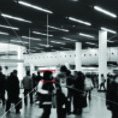Eyes on You
August 31, 2018

If your intuition tells you that you’re being watched at an airport, you’re not wrong. Like most busy public venues today, airports and the Transportation Security Administration understand human surveillance is a critical aspect of public safety. However, it’s a practice that makes passengers feel a little uneasy nonetheless. Some view it as an invasion of privacy, while others worry about the information being collected about them and who sees it. These are very real and understandable concerns in today’s era of database hacks and rogue back-room behavior.
However, several airports around the United States are exploring a new way of following passenger journeys that watches more discreetly and protects people’s identity. McCarran Airport in Las Vegas, San Jose International Airport, Miami International Airport, and a handful of other forward-thinking airports are experimenting with something called LiDAR to monitor passenger flows and behaviors.
LiDAR is a 3D imaging technology best known for its application in autonomous vehicles. With it, airports can observe in real-time the flow of passengers through their facilities. This technology, which uses safe, invisible laser beams to detect objects both in motion and at rest, is more accurate than Bluetooth- or WiFi-based indoor location technology. LiDAR is also better at safeguarding passenger identities than stereoscopic cameras, which actually capture pixelated passenger images. In contrast, LiDAR converts positional data into anonymous 3D point cloud data, fully protecting passenger identities.
A single LiDAR sensor is capable of capturing the exact coordinates and velocity of every person within an area of over 300,000 square feet. And unlike stereoscopic cameras, which require ideal lighting conditions (i.e., enough light to see), have a narrow field of view and perform best in high-ceiling environments, LiDAR sensors can operate in challenging lighting conditions, across all ceiling heights, and their accuracy is not affected by sunlight through airport windows or by poor lighting conditions.
Using the data captured by LiDAR, airports can adjust their operations to help reduce wait times and improve the passenger experience. They can identify foot traffic bottlenecks or see where passengers are moving more quickly. They can understand how wait times build or how long it’s taking passengers to get through TSA checkpoints.
Passengers armed with this airport information may more confidently plan their trip to the airport stress free for this phase of travel. Utilizing LiDAR-generated data, airports can accurately predict “time-to-gate” for their passengers. This data can also be valuable to other travel providers, such as Uber or Lyft, allowing them to suggest alternate pick-up times for their passengers, or point them to the shorter security line, ensuring passengers make their flights on time.
The popular travel planning app, TripIt, is among the first to tap into this airport-generated data in Austin, Orlando, Denver and Phoenix. TripItPro users receive an alert three hours before their flight with current wait times, as well as real-time updates. Airport maps in the app also show the nearest security checkpoints and identify the ones that have the shortest lines.
With a better understanding of “time-to-gate,” airports can also improve their bottom line. Getting travelers to their gates expeditiously gives them more time to spend shopping in retail stores, or grabbing a bite at the concessions – both major revenue-drivers for airports. Airport operators can also use the data to intelligently position their storefronts and indoor advertising to take advantage of foot-traffic flows.
While some people may never appreciate having “big brother” looking on at an airport, the use of LiDAR technology certainly makes the practice much more palatable for passengers – and it’s improving their overall travel experience. So the next time you sail swiftly through a TSA checkpoint, or you’re alerted to leave for the airport a little early, or you have a few spare minutes to eat and shop before heading to your gate – you may actually thank a LiDAR solution for making that all possible.
Sam Kamel is the President & CEO of iinside (www.iinside.com), a leading provider of Indoor Motion Analytics for SMART Airports.




